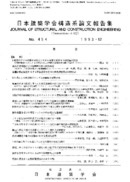413 巻
選択された号の論文の17件中1~17を表示しています
- |<
- <
- 1
- >
- >|
-
原稿種別: 表紙
1990 年 413 巻 p. Cover1-
発行日: 1990/07/30
公開日: 2017/12/25
PDF形式でダウンロード (57K) -
原稿種別: 表紙
1990 年 413 巻 p. Cover2-
発行日: 1990/07/30
公開日: 2017/12/25
PDF形式でダウンロード (57K) -
原稿種別: 目次
1990 年 413 巻 p. Toc1-
発行日: 1990/07/30
公開日: 2017/12/25
PDF形式でダウンロード (60K) -
原稿種別: 付録等
1990 年 413 巻 p. App1-
発行日: 1990/07/30
公開日: 2017/12/25
PDF形式でダウンロード (71K) -
原稿種別: 付録等
1990 年 413 巻 p. App2-
発行日: 1990/07/30
公開日: 2017/12/25
PDF形式でダウンロード (71K) -
原稿種別: 本文
1990 年 413 巻 p. 1-10
発行日: 1990/07/30
公開日: 2017/12/25
PDF形式でダウンロード (1123K) -
原稿種別: 本文
1990 年 413 巻 p. 11-22
発行日: 1990/07/30
公開日: 2017/12/25
PDF形式でダウンロード (1341K) -
原稿種別: 本文
1990 年 413 巻 p. 23-29
発行日: 1990/07/30
公開日: 2017/12/25
PDF形式でダウンロード (979K) -
原稿種別: 本文
1990 年 413 巻 p. 31-39
発行日: 1990/07/30
公開日: 2017/12/25
PDF形式でダウンロード (1086K) -
原稿種別: 本文
1990 年 413 巻 p. 41-52
発行日: 1990/07/30
公開日: 2017/12/25
PDF形式でダウンロード (1344K) -
原稿種別: 本文
1990 年 413 巻 p. 53-64
発行日: 1990/07/30
公開日: 2017/12/25
PDF形式でダウンロード (1339K) -
原稿種別: 本文
1990 年 413 巻 p. 65-74
発行日: 1990/07/30
公開日: 2017/12/25
PDF形式でダウンロード (1147K) -
原稿種別: 本文
1990 年 413 巻 p. 75-86
発行日: 1990/07/30
公開日: 2017/12/25
PDF形式でダウンロード (1973K) -
原稿種別: 本文
1990 年 413 巻 p. 87-96
発行日: 1990/07/30
公開日: 2017/12/25
PDF形式でダウンロード (1188K) -
原稿種別: 本文
1990 年 413 巻 p. 97-106
発行日: 1990/07/30
公開日: 2017/12/25
PDF形式でダウンロード (1040K) -
原稿種別: 付録等
1990 年 413 巻 p. App3-
発行日: 1990/07/30
公開日: 2017/12/25
PDF形式でダウンロード (73K) -
原稿種別: 表紙
1990 年 413 巻 p. Cover3-
発行日: 1990/07/30
公開日: 2017/12/25
PDF形式でダウンロード (7K)
- |<
- <
- 1
- >
- >|
